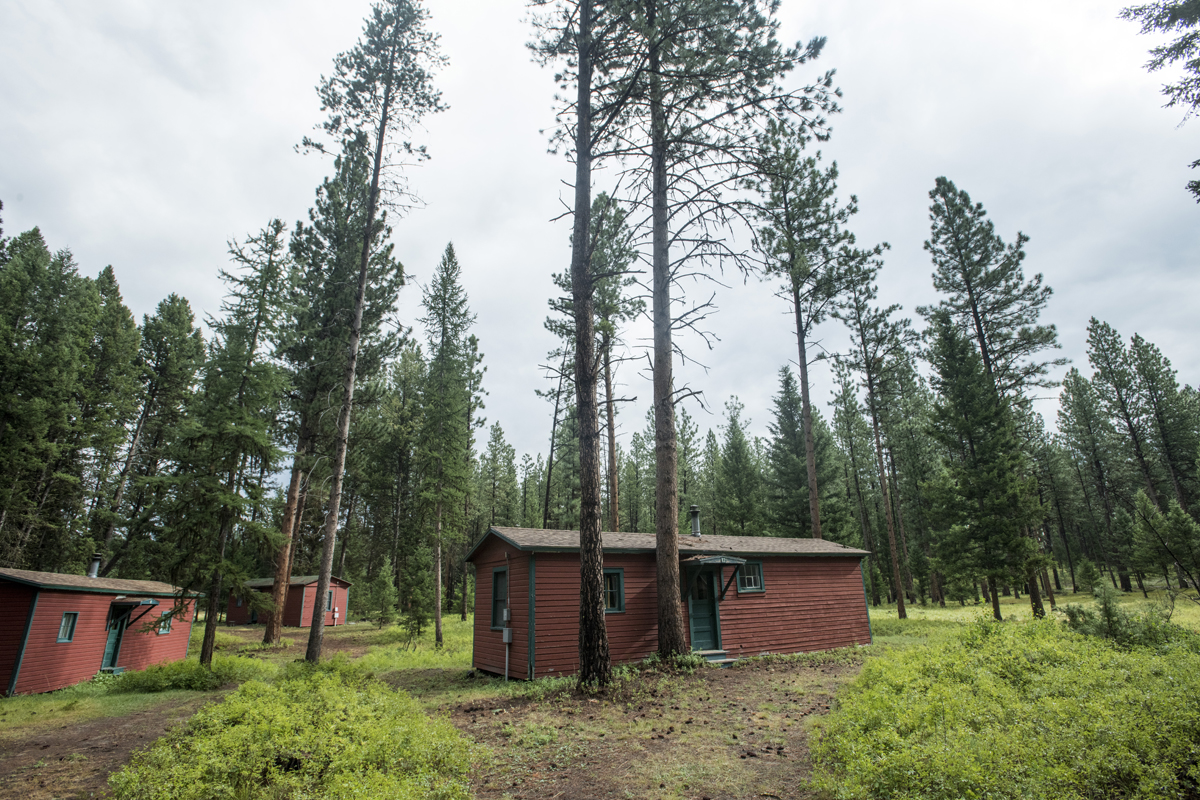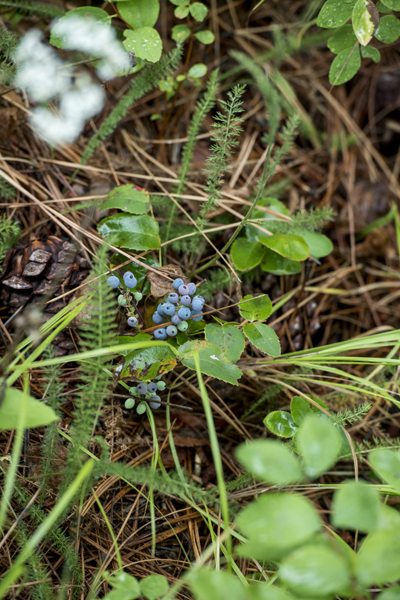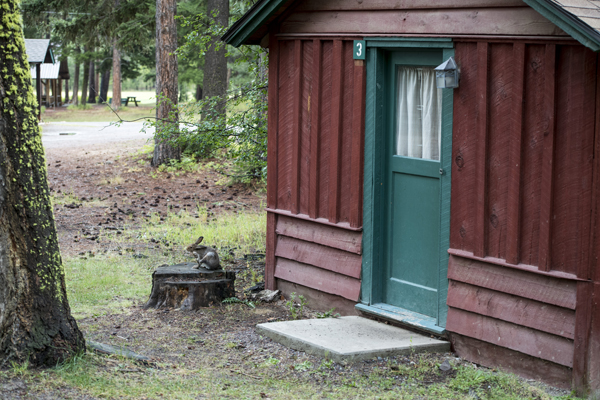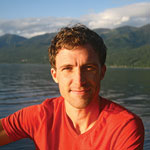- Editorial Offices
- 203 Brantly Hall
- Missoula, MT 59812
- (406) 243-2488
- themontanan@umontana.edu
A Forester's Workshop: Lubrecht Forest is ground zero for UM forestry.
For 82 years, Lubrecht Experimental Forest has served as UM's largest outdoor classroom.
Chris Keyes doesn’t care much for hiking. It’s nothing against the woods — as a research professor at UM’s W.A. Franke College of Forestry and Conservation, Keyes enjoys his time among the trees. It’s just that hiking for pleasure alone feels a little aimless. He would much rather walk somewhere with a purpose.
Which is what he’s doing now, on a hot, midsummer afternoon. He’s blazing up a game trail, tramping over Oregon grape, bunchgrass and mountain aster at UM’s Lubrecht Experimental Forest, a sprawling spread abutting the Blackfoot River, just 30 minutes from campus. Keyes wears a short-sleeved linen shirt tucked into black Carhartts with holes at the ankles. Clicking grasshoppers spring away from his plodding boots. Finally, he stops on the dividing line between two very different stands of trees, ground zero of a 20-year forestry study.
On Keyes’ right are 90-year-old ponderosa pines — tall, healthy trees, widely spaced, with grassy glades in between. The perfect place for a picnic. On his left, the forest is crowded with Douglas-fir saplings and the dry, silvered skeletons of fallen ponderosas — victims of a mountain pine beetle attack.
Keyes is 51, with a sharp nose and an accent that reveals his southern Massachusetts’ roots. These trees tell a story, he explains. The park-like section of forest was first thinned and then treated with a prescribed fire. The other side was only treated with fire. Afterward, the higher density of trees in that stand made it more susceptible to pine beetle infestation, which killed trees and made the stand more vulnerable to wildfire. Nearby, a section of forest was thinned only, and another section served as a control.
One conclusion of this study is that forests treated with thinning and prescribed burns are more resilient to pine beetles and wildfire. Over the past 20 years, UM students and faculty have monitored how these treatments affect wildlife, soils, invasive species, tree growth, pine beetles and more. It’s just one of many study sites at Lubrecht producing decades of data — real-world research that puts UM students in the middle of the science and ideas shaping modern forestry.
“We try to teach students to see this as more than just green stuff, trees and bushes,” Keyes says. “We try to develop their capacity to see forests in four dimensions, to ask: Where is this going over time?”
How did UM end up with a forest of its own? Credit the vision of Thomas Spaulding, dean of the college for 22 years. Spaulding recognized that an experimental forest is the “workshop of the forester,” and he spent 10 years (and 10 cases of Scotch, as the story goes) negotiating with the Anaconda Copper Co. and its mill manager, W.C. Lubrecht, to acquire the land. In 1937, the Anaconda Company transferred 19,000 acres to the University. That year, the Montana Legislature set up the Montana Forest and Conservation Experiment Station — the research arm of the college — to manage the forest. With more land acquired over the years, Lubrecht Experimental Forest now amounts to 28,000 acres, or 44 square miles.
Plenty of other universities have forests, but they tend to be far from campus and much smaller than Lubrecht. (Yale’s School of Forestry and Environmental Studies, for example, manages seven forests across three states with a combined area less than 11,000 acres.) Keyes has visited more than 30 university forests, so he knows how Lubrecht compares.
“No other university has a forest as large, easily accessed and highly visited as ours,” he says. “This place is like the spiritual home of the College of Forestry and Conservation. When alumni come back, this is where many of them want to go first.”
Lubrecht is also a community resource, open to the public for hiking, mountain biking, walk-in hunting and Nordic skiing. People get married there, and have reunions. The forest is a training site for federal and state agencies like the U.S. Forest Service and the Department of Natural Resources and Conservation. It’s a venue for nonprofit retreats, quilter conventions, whitewater canoe races and more.
 One day in the woods, Keyes stepped out of his car and noticed a young man in fatigues inch-worming his way through a culvert. He was an ROTC student conducting a simulated mission. Another time, Keyes turned a corner and saw a body in the road with a pine bough in its chest and blood everywhere. It was a prop for a wilderness first-responder course.
One day in the woods, Keyes stepped out of his car and noticed a young man in fatigues inch-worming his way through a culvert. He was an ROTC student conducting a simulated mission. Another time, Keyes turned a corner and saw a body in the road with a pine bough in its chest and blood everywhere. It was a prop for a wilderness first-responder course.
The facilities at Lubrecht’s Camp Loop range from the newer “Upper Camp,” with conference rooms, labs and a lodge, to the older, more rustic “Lower Camp,” complete with a recreation hall, a cookhouse, seven boxcars turned into bunkhouses, and seven small cabins built by forestry students in the 1950s.
From 1957 to 1969 and again from 1976 to 1992, students spent the entire spring quarter at Lubrecht, learning about forestry and sleeping in the boxcars and cabins. The college doesn’t hold a spring camp anymore, but students still develop skills and camaraderie at Lubrecht with classes and events like the Fall Smoker, a bonfire and barbecue at Jones Pond. Early on, students get an orange vest, tape measure, compass and clinometer and learn “timber cruising” ̶ the art of calculating a forest’s timber. Later, they can make management decisions on a student-run square mile of Lubrecht called Section 13.
“They’re working with their hands, using actual tools,” says Dean Tom DeLuca, who started bringing students to Lubrecht in the 1990s as a soils professor. “There’s a whole lot you can do up there. It’s convenient, and it’s ours.”
Wood sciences Professor Ed Burke takes students to Lubrecht to learn how to operate a small sawmill. Professor Kelsey Jencso, Montana’s state climatologist, maintains a comprehensive watershed monitoring system on Elk Creek, a Blackfoot tributary that runs through Lubrecht.
“In a smaller forest, you couldn’t afford to set aside a whole watershed for research,” DeLuca says. “We can set up these long-term research sites and let them rip. We don’t have to get permission.”
The promise of expansive research possibilities so close to campus is part of what drew Justin Crotteau to pursue his Ph.D. here in 2014. Crotteau spent three summers in Lubrecht researching mountain pine beetle activity and wildfire vulnerability in forests treated with thinning and controlled burns.
Crotteau recalls visiting Lubrecht for the first time. “I really felt excited about being able to spend time there,” he says. “It’s like a playground for research and forestry experience. And I immediately felt some ownership of it.”
In the research he did, the classes he took and the courses he taught, Crotteau found that there was no substitute for the boots-on-the-ground learning at Lubrecht. “You start to realize that there’s forestry that you learn in a book, and there’s forestry that you need to get done, that’s very practical.”
Crotteau is now applying these skills to his job as a research forester for the U.S. Forest Service in Juneau, Alaska. He says the research conducted in Lubrecht is applicable across the West, because the forest type — ponderosa pine, Douglas fir and larch — is so widespread. Individual landowners right up to the federal government can draw on that research to become better stewards of forests.
“Our values have diversified,” Crotteau says. “In the past, forestry was very much commodity-driven, wood-driven. Now, our commodities also include recreation, water and resilience to insects and fire.”
Lubrecht’s management has reflected those shifting values. In the timber-hungry 1960s, the forest produced nearly 1.3 million board feet of lumber each year. Lubrecht is still actively managed for timber, and students help design and oversee actual harvesting operations. (Not to mention the annual “Pole Run,” in which the Forestry Club fells 400 lodgepole pines to build the set for the Foresters’ Ball.)
In the near future, Lubrecht may contribute 500,000 board feet of lumber for a new College of Forestry and Conservation building on campus that will use small-diameter trees in a sustainable new material called cross-laminated timber. Dean DeLuca also would like the forest to generate its own energy by adding a solar array to the field in Lower Camp, and by using biomass fuel from thinned trees to heat the buildings in winter.
 To illustrate another future possibility, Chris Keyes is beelining through the woods again as a pair of squirrels chitter and chase each other around a tree. Keyes wades into a fragrant clump of Douglas-fir regeneration — perfect Christmas trees — and finds a stake in the ground. It’s the center of a resource inventory plot, one of 300 scattered around the forest. The trees in this plot are numbered, and their vital statistics —height, diameter, volume — are closely monitored. These measurements, though, aren’t made to determine how many board feet of lumber the trees could produce, but how much carbon they are storing.
To illustrate another future possibility, Chris Keyes is beelining through the woods again as a pair of squirrels chitter and chase each other around a tree. Keyes wades into a fragrant clump of Douglas-fir regeneration — perfect Christmas trees — and finds a stake in the ground. It’s the center of a resource inventory plot, one of 300 scattered around the forest. The trees in this plot are numbered, and their vital statistics —height, diameter, volume — are closely monitored. These measurements, though, aren’t made to determine how many board feet of lumber the trees could produce, but how much carbon they are storing.
Keyes explains that Lubrecht is exploring the process of entering California’s cap-and-trade carbon offsets market, in which companies can offset their emissions by paying for the protection of carbon-storing forests. It’s a novel idea, and the certification procedure is rigorous, but Keyes is optimistic it could be a significant revenue source for Lubrecht. The move wouldn’t preclude harvesting timber in the forest, he says, and it would create exciting new teaching opportunities.
“People tend to think of forestry as a 20th-century profession,” he says. “But this will be putting our students at the cutting edge of a whole new way of looking at forests.”
Managing a forest for its carbon might sound antithetical to traditional forestry, but Keyes doesn’t see it that way. Ever since Lubrecht was first logged in the late 1800s by teams of oxen and lumberjacks with crosscut saws, forestry has been evolving. And having a forest like Lubrecht — a workshop for faculty and students to tinker in — ensures that the College of Forestry and Conservation evolves with it.
“Forestry is not the science of cutting down trees,” Keyes says. “It’s the study of forests as a long-term venture. We’re hands-on conservationists with a lot of patience.”

Story by: Jacob Baynham
Jacob Baynham graduated from UM with a journalism degree in 2007. He writes for Outside, National Parks, and other magazines. He lives in Missoula with his wife, Hilly McGahan ’07, and their two sons.




